Erica Salinas (aka Mary Puppins) is a certified dog trainer and owner of Salinas K9 Training in NYC. If you have something you want to ask Mary Puppins be sure to email us at jamie@dogspotted.com!
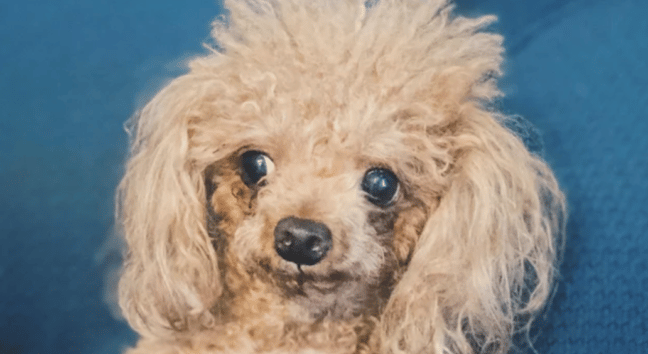
Dear Mary Puppins: Building Confidence and Trust with a Fearful Dog (step-by-step guide)
I adopted a 6 year old poodle mix a little over 6 months ago. He was severely neglected and abused and spent his whole life in a puppy mill. Needless to say when I got him we were starting from scratch. He has come so far and has the sweetest little disposition. Even though he has done a 180, he’s still very nervous, even around me. He will finally take treats from my hand but he is quite cautious, almost like he is expecting to get hit. He follows me around in the house and on the leash never pulls, but he is happiest at a distance.
So my question is how can I start to train him to at least sit, stay, and basic recall. He isn’t food motivated at all, and will even say no to cheese if he’s scared. I don’t want to push him, but for safety reasons I want to make sure we have the basics down.

Thank you so much for wanting more for your furchild! Overcoming fear for humans can be a lifetime of work, as for dogs. I will provide various ways to help you and your dog. Consistent repetitions and patience are key when working with a fearful dog. Based on your question and the additional information you have provided, I know you’re willing to do whatever it takes to help him.
The Tools Needed and Why
Overview
- Leash (I like to use a slip leash)
- Clicker (If your fearful dog isn’t afraid of the clicker.) and/or Marker Word “Yes”
- Marker Word “Yes”
- Treats/Food (whatever the dog considers a treat: food, praise, touch or toy)

You can also use your standard leash by clipping it to your dog’s collar, but you want your dog on a leash when training so you can easily guide them back to you if they get distracted or try to walk away. If you don’t have your dog on a leash and your dog leaves during training, the moment has passed and the dog missed the learning opportunity.
Clicker and/or Marker Word “Yes”

The clicker and/or marker word “yes” are both used to encourage the behavior you want. Many people feel overwhelmed with the addition of a clicker which is understandable, but using a clicker is known to enhance the speed of learning for a dog when used correctly. When using a clicker and/or marker word “yes” timing is everything. The mark MUST be at the exact moment your dog performs the command. You then follow the click/marker word with a treat each time.
If using a clicker, when first teaching a command, only click to mark the completed behavior. Once your dog is starting to understand the command, click and say “yes” at the exact same time to mark the behavior. When your dog is performing the command at least 80% of the time you can remove the clicker and only say “yes.” This is how you transition away from using the clicker.
If you choose to not use a clicker you can then ALWAYS use the marker word “yes” to mark the behavior you want. This is something you will do for the rest of the dogs life. Here’s a video to learn more about clickers when it comes to dog training.

I am a huge advocate for using your dog’s kibble as training treats, as long as they will work for kibble. So many training treats are filled with unwanted calories and chemicals so they smell and taste better to the dog. Using a dog’s kibble has them working for their food which is always positive. It will also save you money.
If your dog won’t work for their kibble, the treats I recommend are Redbarn Rolled Food. It comes in beef, chicken, and lamb. I cut the entire roll into thirds and cut the thirds into strips. You’ll see how easy it is to break apart and make the treats the size you want. This is dog food, so I recommend staying with the same protein as your dog’s food to not upset their tummy. Also, be sure to refrigerate once opened, as it will mold quickly if left outYou can also pre-cut and freeze. That way you can take it out when needed and will last longer.
When a dog is fearful of anything: dogs, humans, trash cans, bicycles, etc. you first start with pairing these things with food so the dog starts to have a positive association each time they see the stimulus that causes a reaction.
Dog Spotted even has discount codes for dog training treats – you can check them out here.
Where to Start Training
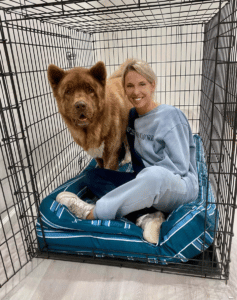
To build confidence, you always want to start training inside so there are as few distractions as possible. Once your dog is at least 90% responsive to the commands you can start to slowly take it outside.
Two Ways to Build Confidence
1. Eye Contact
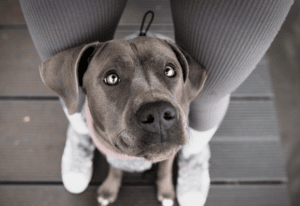
There are several ways to build confidence, I’m going to concentrate on the two that I always start with.
I’m sure you’re familiar with shy children that avoid eye contact? The same goes for fearful dogs. Yes, there are dogs that aren’t fearful that don’t give you eye contact but that’s because they have not been rewarded for eye contact. So, that is why I start with eye contact.
Eye contact from a dog is the highest compliment a dog can pay you. It also means the dog is looking to you for guidance. So. why is eye contact so important? When your dog is fearful, you want your dog to look to you so you can provide guidance. If your dog is leash reactive, you want your dog to see the stimulus then look at you for guidance. So implementing eye contact is extremely important.
1a. Teaching Eye Contact
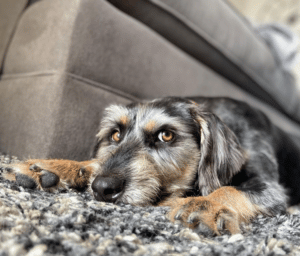
To familiarize your dog with eye contact, you will start by rewarding them every time they give you eye contact.
How to do this:
1. With the dog on leash, sit on the floor using their mealtime and kibble to train and reward.
2. As you’re sitting, wait for your dog to give you eye contact (you will have to be patient.)
3. The dog can be standing, sitting, or laying down – depends on what is most comfortable for them.
4. The second your dog gives you eye contact, click and/or say “yes” then reward them by giving them one piece of kibble.
5. Repeat over and over and over again. Note: I do not teach “look” or “watch me” because I don’t want my dog to only look at me when I give them the command to look at me. I want them to look at me knowing they are rewarded via a “yes” which is praise and/or treat making this action positive.
During this time you’re teaching your dog that giving eye contact leads to a reward, you will want to observe your dog while not in a training session and ALWAYS reward every time your dog gives you eye contact. So, if you’re watching TV and you notice your dog looks at you say “yes” then give a treat. Yes, you will need to reward via treats after each marked behavior because this is the learning phase for your dog. Once the dog is 80% responsive you can start to sporadically give treats after each marked behavior to keep them working.
As mentioned earlier, training outside is the most distracting place for a dog. So again, be sure to observe your dog and if/when your dog looks at you have a praise party by saying “yes” then reward generously.
Once eye contact is more frequent, you can start to work on basic obedience.
2. Don’t Feed your dog Out of a Bowl

Another amazing way to build confidence in a dog is to not feed them out of a bowl. I know, strange!? I suggest using a meal or part of a meal to teach eye contact. with the remainder of the meal distributed out of a Kong or other food dispensing toy. Feeding out of a bowl gives nothing back to the dog except free food.
When a dog eats out of a Kong, with each lick of food the dog is rewarding itself, therefore building confidence. The dog is doing all the work all by themselves. Using a food-dispensing toy is another great way to build confidence. It can be a Kong Wobbler or similar product, West Paw Rumbl, Starmark Ball Dispenser or any other kind of food dispensing toy. There are so many options!
I realize some people will doubt this but I have seen hundreds of dogs go through this process and quickly build confidence.
My Advice:
Start with kibble in the Kong, shake the Kong back and forth so your dog understands how the food comes out. Before you know it, your dog will be tossing it around to get the food out.
To make it a bit harder you can then moisten the kibble with water. I like to put kibble in a bowl and add water and let it soak overnight. It expands like marshmallows. You can then really stuff the moistened kibble in the Kong to make it a bit more difficult. I like to layer moistened and dry kibble to give my dog a litter texture variety.
The next level is freezing the moistened kibble which can keep a dog focused and motivated for 30 minutes to an hour while trying to eat their frozen meal. Another way to level up is hide treats like bacon or boiled chicken throughout the Kong as extra motivation and a special treat. YUM!
Lastly, for community support there is an amazing private Facebook group, Beyond The Bowl – Canine Enrichment, that offers unique ways to not feed your dog out of a bowl. In addition to building confidence, this is another fantastic way of expelling energy and providing mental stimulation.
Wrap Up
Fearful dogs need patience and consistency. Trying something for a few days will not help your dog learn or understand what you’re asking of them, so be patient. Once your dog starts to master eye contact while not eating meals out of a bowl, you will start to see their confidence grow. Again, these are just a couple of ways I help clients build confidence. There are many other exercises to use but these two are my foundation and favorite.
Daily exercise, structure/routine, obedience, consistency and patience is what I consider to be a solid foundation for all dogs to be happy and healthy. Remember that your dog is never trained, but always training.

When a dog is fearful of anything, start pairing these things with food to allow the dog to have a positive association.
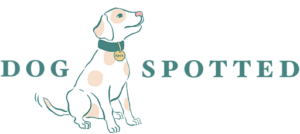


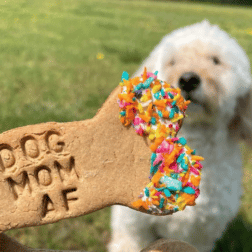

Conversation